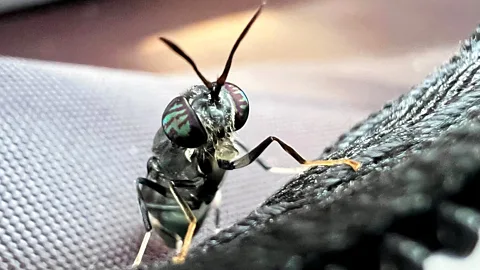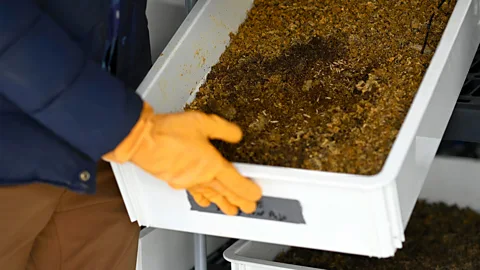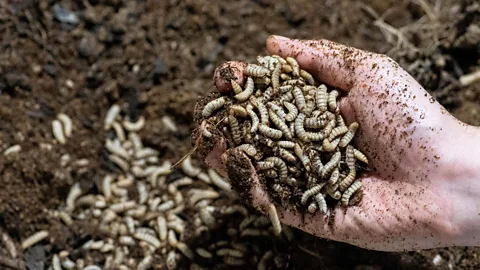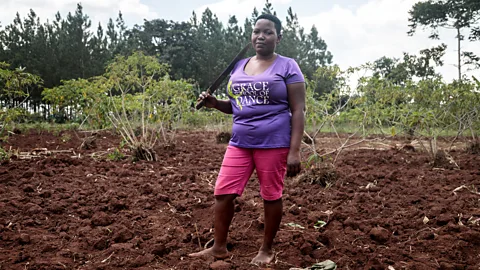The little bug with a big appetite turning organic waste into sustainable fertiliser
 Chapul Farms
Chapul FarmsThese tiny soldiers can eat four times their own weight in organic waste – and turn it into sustainable fertiliser.
With a unique ability to consume nearly any form of organic matter it comes across, one small but mighty insect is becoming a tool to address the growing problem of organic waste and soil degradation. The bug, black soldier fly larvae (BSFL), transforms food waste into nutrient-rich biofertiliser: frass.
Insects have been long been used in agricultural practices as a food source – but now farmers are exploring the potential of bug poo as a sustainable fertiliser. With over 33% of the world's soil currently degraded, depleted of the nutrients necessary for healthy plant growth, frass can play a major role in restoring soil biodiversity and quality.
In May 2024, the US Department of Agriculture (USDA) awarded grants to three projects that seek to harness this soldier fly's capabilities. This included Chapul Farms, an Oregon-based project development company that's reweaving insects back into American agriculture to eliminate food waste, restore soil health, and produce high-quality animal feed.
Backed by the Fertilizer Production and Expansion Program (FPEP), the bipartisan support of the use of insects in agriculture highlights the growing recognition of BSFL's potential – for both waste reduction and for enhancing soil health through the production of high quality domestic fertiliser.
But despite the bug's seeming superpowers, the widespread application of BSFL remains limited. The question is: why? And how can companies like Chapul Farms, now equipped with federal support, change that?
 Chapul Farms
Chapul FarmsBSFL can consume nearly any kind of organic waste, from food scraps to agricultural byproducts. Facilities like Chapul Farms utilise its voracious appetite to process large quantities of waste, with the larvae consuming up to four times their own body waste in organic matter everyday. This happens in a fraction of the time required for traditional composting, which can take up to 10 months. The larvae's efficiency allows for a rapid turnover of organic material into nutrient-rich excrement – or frass.
"They can reproduce pretty quickly too," says Shankar Ganapathi Shanmugam, assistant research professor in the department of plant and soil sciences at Mississippi State University. "And it [BSFL] grows on dead and decaying material, which means that it can survive on waste."
Shanmugam is spearheading research on the use of frass as a crop nutrient, which until now has not been studied in the US – though it has been studied in other parts of the world, notably in multiple countries across Europe.
Chapul collaborates with neighbouring farms to exchange waste for frass, creating a circular system. It's a mutually beneficial exchange as the farms receive nutrient-rich soil amendment and Chapul receives the fuel for their operation. And it's doing something significant for insect populations too: helping to repopulate them.
This is because insect farming operations create a controlled environment for the bugs to thrive. The frass created from them provides essential nutrients to plants and fosters a more biodiverse soil, which encourages the growth of native plant and insect species, thus supporting the overall ecosystem.
Carbon Count
The emissions from travel it took to report this story were 0kg CO2. The digital emissions from this story are an estimated 1.2g to 3.6g CO2 per page view. Find out more about how we calculated this figure here.
"We could make compost out of anything but the impact of running it through this insect biology has all of these [positive] implications," says Mimi Casteel, an Oregon wine farmer who has been using Chapul's frass. "It's exciting for so many reasons: it's a portable, pretty low cost investment compared to some other things that we're considering as part of dealing with our massive problems with waste, and soldier flies are replacing a missing layer of diversity."
Chapul has worked with local vineyards, researchers and farms to research, educate and promote frass benefits and adoption in the bioregion. TAINABLE, a local soil restoration non-profit, provides laboratory space and farmland to Chapul for their research.
As organic waste production continues to place a massive burden on energy and carbon emissions, there is an increasing need for more efficient and sustainable processing methods. And BSFL's digestive processes can significantly reduce greenhouse gas emissions.
"Finding a use for this is important, but if you're going to market frass as a fertiliser, you need to regulate it, which takes time," says Shanmugam. "And to make these regulations you need research."
The US National Organic Program does not include insects as an acceptable additive as of now. This makes it a challenge to share this technique with farmers who use organic practices, though teams like Chapul Farms are in conversations with regulators to increase education around it and usher in its inclusion.
 Getty Images
Getty ImagesUnlike chemical fertilisers, which often deplete soil over time, frass promotes biodiversity within the soil by introducing a diverse microbial community. This boosts soil resilience, natural plant defence, improves its ability to retain water, and reduces the need for costly synthetic inputs. In sharp contrast, synthetics can wreck soil biodiversity, beneficial bacteria and the soil's natural micro-ecosystem, leaving it dependent on increasingly expensive inputs. They also have intensive fossil-fuel requirements, and reduce soil's carbon carrying capacity.
"We recently saw even more of a push for our government to get projects funded that support domestic fertiliser production," says Aly Moore, chief communications officer of Chapul Farms. "We realise how many health issues are caused by the reduced nutrient density in crops, and all the pesticides used. And on the cost factor, farmers will not only need less fertiliser over time, but also fewer pesticides."
This can all contribute to cost savings and be more incentive for farmers, especially at a time when fertiliser prices are sky high and supply is unreliable. Prices more than doubled between 2021 and 2022. With the US being the world's third-largest fertiliser importer, American farmers felt the brunt of this impact; making it not just a fertiliser issue, but also one of food security.
"In the two years leading up to 2023, there was an 8% reduction in global fertiliser consumption, because people were priced out of the market," says Michael Place, chief technology officer at Chapul Farms. "There were supply disruptions and even unavailability. And FPEP emerged from this sort of emergency."
Soil microbes present an exciting frontier for regenerating soil health, yet less than 1% of total microbes in soil have been cultivated. Frass provides an opportunity to pivot from the reductionist methods of treating soils that perpetuated the soil crisis in the first place, all while bolstering food and agricultural security.
Farmers will eventually need less frass to maintain the same levels of soil productivity, as the microbes in frass proliferate over time, rebuilding soil health and resiliency by improving biodiversity.
Farmers who have begun using frass in their fields are already reporting promising results. Casteel is in the midst of facilitating trials to assess the impact of frass on her crops. While the statistical outcome of the study is still in progress, she has already witnessed perceptible changes.
"Anecdotally, what I can tell you is that in the trials that I've done both with grapevines and in my vegetable farm, the produce itself comes up faster, it has better cellular structure," says Casteel. "So if you actually cut the leaf and put it under the microscope, the cells grow more densely and they have figure lipid membranes. And what that means is that the plant from day one has more structural integrity," she says.
The FPEP funds will support construction and equipment for BSFL facilities located in Oregon and North Dakota. The projects anticipate yielding 10,000 tons of frass per location per year and will generate 59 new jobs, upon its opening which is expected to be in 2026.
One of the greatest challenges facing the nascent insect agriculture industry is the tunnel vision around insects for protein production which has overshadowed the benefits of frass in soil health. While protein from BSFL is a lucrative and fast-growing market, frass remains an underutilised resource in insect agriculture.
 Getty Images
Getty ImagesThe global insect protein market was valued at nearly $1 billion in 2022 (£805m), while global frass was valued at $96 million (£77m) in 2023, and frass's projected growth is substantially higher. Plus, according to the Chapul Farms team, insect farms produce twice as much frass as larvae.
"I think farmers have historically been convinced that insects are problems, and they just don't want to talk about adding more problems to their situation," says Casteel. "But when our farms become more complex, you start to see an exponential rollout of ecological returns."
In addition, insects are keystone species, meaning entire ecosystems would drastically change or collapse without them – and our world would "grind to a halt", as the biologist Dave Goulson wrote in the Guardian newspaper.
"Ultimately, at its core, we cannot survive without insects," says Pat Crowley, CEO of Chapul Farms. "Natural ecosystems cannot flourish... without the insects as a part of them. And that's one of our biggest premises. It's not as simple as: insects will solve the biggest trends in global agricultural health. And at the same time, I think it's one of the biggest levers that we have in making agriculture a more resilient, ecosystem-based model."
--
For essential climate news and hopeful developments to your inbox, sign up to the Future Earth newsletter, while The Essential List delivers a handpicked selection of features and insights twice a week.
